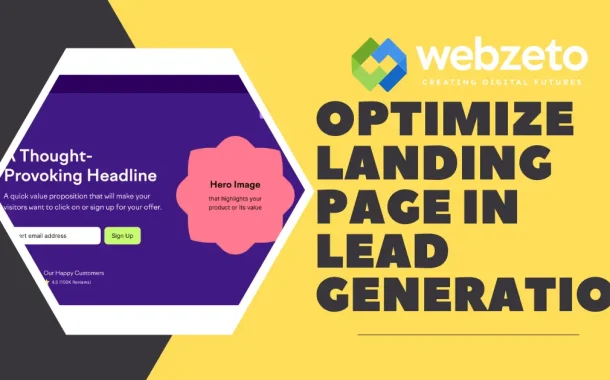To optimize a landing page, focus on key strategies: create a compelling headline that grabs attention, design a clean and simple layout, and write persuasive content that speaks to your audience’s needs. Use strong calls-to-action (CTAs) to guide users on what to do next. Incorporate high-quality visuals and social proof, like testimonials, to build trust. Ensure your forms are easy to fill out and test different elements to see what works best.
Table of Contents
Table of Contents
1. Crafting a Compelling Headline
Crafting a compelling headline is crucial for grabbing attention and encouraging visitors to stay on your landing page. A strong headline should be clear, concise, and directly address the main benefit or solution your page offers.
- Be Clear and Specific: Avoid vague language. Clearly state what the visitor will gain. For example, “Boost Your Sales by 30% in 30 Days” is more effective than “Improve Your Business”. Specific headlines set clear expectations and reduce ambiguity, making visitors more likely to engage.
- Highlight a Benefit: Focus on what the user will get out of your offer. For instance, “Get a Free Guide to Improve Your SEO” tells users exactly what they can expect. Emphasizing the benefit helps users immediately see the value of your page, increasing their interest.
- Use Strong, Action-Oriented Words: Words like “Discover,” “Learn,” “Boost,” or “Get” can prompt users to take action. Action-oriented language encourages immediacy and can drive higher engagement and conversions.
- Keep it Short and Sweet: Ideally, your headline should be no longer than 10-15 words. It needs to be easily readable at a glance. Shorter headlines are easier to digest and more likely to grab attention quickly in a crowded digital landscape.
- Include Numbers or Statistics: Numbers can make your headline more concrete and credible, like “5 Tips to Double Your Website Traffic”. Specific figures can add a sense of authority and make your promise more tangible to the reader.
- Ask a Question: A question can engage users’ curiosity, such as “Want to Save More on Your Monthly Bills?” Questions can also address a common problem, making users feel understood and eager to find the solution on your page.
- Test Different Headlines: Use A/B testing to compare different headlines and see which one performs best. Continuous testing allows you to refine your headlines based on real user responses, leading to higher conversions over time.
2. Designing a User-Friendly Layout
Designing a user-friendly layout is crucial for keeping visitors on your landing page and helping them take action. A good layout is clean, organized, and visually appealing. It makes it easy for visitors to find what they need without feeling overwhelmed.
First, focus on a clean and simple design. Avoid too many graphics, text, and buttons. A clutter-free page helps users focus on the important parts, like your headline and call-to-action. Use white space to give your content room to breathe and make it more readable.
Next, make sure your page is mobile-friendly. Many people will visit your page on their phones or tablets. A responsive design adjusts to different screen sizes, making sure your page looks good and works well on any device. This improves user experience and helps your page rank higher in search results.
Finally, keep your branding consistent. Use the same colors, fonts, and styles that match your brand identity. This builds trust with your audience. Also, ensure your page loads quickly by optimizing images and using efficient coding. A fast-loading page keeps visitors from leaving before they see your content.
3. Creating Persuasive and Relevant Content
Creating persuasive and relevant content is key to converting visitors on your landing page. Your content should be clear, concise, and directly address the needs and interests of your audience. By providing valuable information and presenting it in an engaging way, you can motivate visitors to take action.
First, focus on writing clear and concise copy. Get straight to the point and avoid unnecessary jargon. Use short sentences and paragraphs to make your content easy to read. Highlight the main benefits of your offer and explain how it solves your audience’s problems. This helps visitors quickly understand the value of what you’re offering.
Next, address your audience’s pain points and offer solutions. Show empathy by acknowledging their challenges and then presenting your product or service as the answer. Use bullet points and subheadings to break up the text and make important information stand out. This makes it easier for visitors to scan your content and find what they’re looking for.
Finally, use a friendly and engaging tone. Write as if you’re having a conversation with the reader. This helps to build a connection and makes your content more relatable. Include testimonials, case studies, or quotes from satisfied customers to add credibility and trust. These elements provide social proof and can persuade visitors that your offer is worth their time and investment.
4. Incorporating Strong Calls-to-Action (CTAs)
Incorporating strong calls-to-action (CTAs) is essential for guiding visitors on your landing page toward taking the desired action. CTAs are the prompts that tell your visitors what you want them to do next, such as “Sign Up Now”, “Get Your Free Guide” or “Contact Us Today”. Effective CTAs are clear, compelling, and strategically placed to maximize conversions.
First, focus on the placement and design of your CTAs. Position your primary CTA prominently above the fold, so it’s one of the first things visitors see without scrolling. You can also include additional CTAs throughout the page, especially after sections that provide valuable information or address key benefits. Make sure your CTAs stand out visually by using contrasting colors, bold fonts, and sufficient white space around them.
Next, write action-oriented CTA text that is clear and direct. Use strong, urgent language that encourages immediate action. Phrases like “Download Now”, “Get Started” or “Claim Your Discount” create a sense of urgency and clearly state what the user will get by clicking. Avoid vague terms like “Submit” or “Click Here,” as they don’t convey the specific action or benefit.
5. Using High-Quality Visuals
Using high-quality visuals on your landing page is essential for capturing attention and conveying your message effectively. Visuals can enhance the user experience, make your content more engaging, and help to communicate complex information quickly.
First, choose relevant images and videos that support your message. High-quality visuals should directly relate to your product, service, or the benefits you’re offering. For example, if you’re promoting a fitness program, include images of people exercising and videos demonstrating workouts. This helps visitors immediately understand what your page is about and makes the content more relatable.
Next, focus on the impact of visuals on engagement. Well-chosen images and videos can evoke emotions and create a connection with your audience. Use visuals to tell a story or illustrate a point more vividly than text alone. For instance, customer testimonials can be more powerful when presented as short video clips rather than written quotes. This can increase the perceived credibility and authenticity of your testimonials.
6. Building Trust with Social Proof
Building trust with social proof on your landing page is crucial for convincing visitors to take action. Social proof demonstrates that others have had positive experiences with your product or service, which can significantly boost your credibility and persuade potential customers to trust you.
First, include testimonials and reviews from satisfied customers. Displaying genuine, positive feedback can reassure visitors that your product or service delivers on its promises. Use quotes from real customers, including their names and photos if possible, to add authenticity. Position these testimonials prominently on your landing page, such as near your call-to-action or alongside key benefits.
Next, showcase case studies and success stories. Detailed case studies can provide in-depth examples of how your product or service has helped others achieve their goals. Include specific metrics and outcomes to make these stories more compelling. Success stories, even if shorter, can also highlight individual achievements and relatable scenarios, making it easier for potential customers to envision their own success with your offering.
Additionally, display trust badges and certifications. Trust badges, such as security seals, industry certifications, or awards, can reinforce your credibility and signal to visitors that your business is trustworthy and reputable. Place these badges in visible areas, such as near your call-to-action or at the bottom of your landing page, where they can provide reassurance without distracting from your main message.
7. Optimizing Forms for Conversion
Optimizing forms for conversion is crucial for ensuring that visitors on your landing page take the desired action, whether it’s signing up for a newsletter, requesting a quote, or downloading a resource.
First, minimize the number of form fields. Long forms can be intimidating and may deter visitors from completing them. Only ask for essential information that you need to fulfill the purpose of the form. For example, if you’re offering a newsletter subscription, asking for just an email address is usually sufficient.
Next, ensure form usability and accessibility. Make sure your form is easy to fill out by using clear labels, placeholders, and inline validation. Users should understand what information is required in each field and any formatting requirements. Additionally, ensure your form is accessible to all users, including those using assistive technologies like screen readers.
Implement progressive profiling. Instead of asking for all information upfront, use progressive profiling to gather additional details over time. Start with basic information and gradually collect more data as users interact with your brand more. This reduces form abandonment rates and provides a better user experience.
Moreover, optimize the form layout and design. Position your form prominently on the page, preferably above the fold, so it’s immediately visible to visitors. Use contrasting colors for the form fields and the submit button to make them stand out. Also, consider using multi-step forms if you have a lot of fields to minimize overwhelm and improve completion rates.
8. Improving Page Load Speed
By implementing these strategies to improve page load speed, you can enhance user satisfaction, reduce bounce rates, and increase conversions on your landing page.
- Optimize images and multimedia: Compress images and videos to reduce file sizes without compromising quality. Use the appropriate file formats (e.g., JPEG for images, MP4 for videos) and consider lazy loading techniques to only load media when it’s needed, improving initial page load times.
- Minimize HTTP requests: Reduce the number of elements (e.g., scripts, stylesheets, images) on your page to minimize the number of HTTP requests required to load it. Combine and minify CSS and JavaScript files to decrease file size and reduce server requests.
- Enable browser caching: Leverage browser caching to store static resources (e.g., images, CSS, JavaScript) locally on visitors’ devices, allowing subsequent visits to your page to load faster by retrieving cached files instead of downloading them again from the server.
- Use content delivery networks (CDNs): Distribute your website’s content across multiple servers located in different geographic regions using CDNs. This reduces latency by serving content from servers closer to visitors, improving load times regardless of their location.
- Optimize server response time: Improve your web hosting infrastructure and optimize server configurations to reduce server response times. Minimize server-side processing and utilize caching mechanisms to generate and deliver dynamic content more efficiently.
- Prioritize above-the-fold content: Load critical above-the-fold content first to ensure that visitors see meaningful content without waiting for the entire page to load. Prioritize rendering of essential elements, such as headlines, CTAs, and key images, to provide a fast initial user experience.
- Monitor and optimize performance: Use tools like Google PageSpeed Insights, GTmetrix, or Pingdom to analyze your page load speed and identify performance bottlenecks. Address issues such as render-blocking resources, unused CSS/JavaScript, and slow third-party scripts to optimize performance further.
FAQs
Q. Why is mobile responsiveness important for landing pages?
Mobile responsiveness ensures that your landing page looks and functions well on smartphones and tablets, catering to a large portion of users who browse the internet on mobile devices.
Q. How can I track the performance of my landing page?
You can track the performance of your landing page using tools like Google Analytics, which provide insights into metrics such as traffic, conversions, and user behavior.
Q. What types of A/B tests can I conduct on my landing page?
You can test various elements like headlines, CTA buttons, form fields, and images to see which versions perform better in terms of conversion rates and engagement.
Q. Are there any legal considerations when optimizing a landing page?
Yes, it’s important to ensure that your landing page complies with relevant laws and regulations, such as data privacy laws like GDPR or CAN-SPAM Act for email marketing.
Q. How can I ensure my landing page is optimized for SEO?
You can optimize your landing page for SEO by including relevant keywords in your content, optimizing meta tags and descriptions, and ensuring fast page load times, among other techniques.
Conclusion
Optimizing your landing page for lead generation is crucial for converting visitors into valuable leads. By implementing the strategies outlined in this article, you can create a landing page that effectively captures attention, communicates value, and encourages action. Remember to focus on crafting compelling headlines, designing user-friendly layouts, and incorporating strong calls to action to guide visitors toward conversion.
Continuous testing and iteration are essential for refining your landing page and maximizing its effectiveness over time. Use A/B testing to experiment with different elements and analyze performance data to make informed decisions. Additionally, prioritize user experience by ensuring fast page load speeds, mobile responsiveness, and clear navigation.














